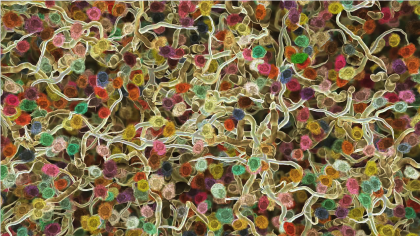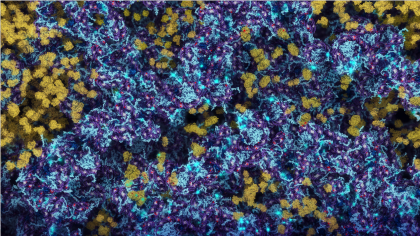
Academic
Career Profile
Please introduce yourself. What is your current training/educational status and/or where do you work? How did you decide to get into scientific visualization?
I work as a biomedical animator at the Walter and Eliza Hall Institute of Medical Research in Melbourne, Australia, with Drew Berry. I have a Masters in Biomedical Sciences from Rockefeller University, New York, USA, and a Graduate Diploma in Animation from RMIT, Melbourne. In my early 20s I was very keen on becoming a research scientist and was enrolled in the PhD program at Rockefeller University. It was thrilling to be doing research amongst some of the best in the world, but after a few years I felt that something was missing in my own work. Towards the end of graduate school, I was approached by the communications department at Rockefeller to provide scientific guidance for some animations they wanted to prepare for the university website and I saw the huge potential for animation. I then stumbled across Drew Berry’s animations on DNA replication and it blew me away. From then on, I knew that that’s what I wanted to do. I left the PhD program with my Masters and flew back to Australia (my home country) and not long after I enrolled in an animation course at RMIT.
What do you like the most about this field?
I love that it is both technically challenging and visually creative at the same time. It keeps both sides of my brain occupied and happy.
How and where did you acquire your current skillset in scientific visualization? Was it all via a graduate or other program or are you self taught? If so, did you use any particular online resources to help with your training?
My science qualifications were gained through formal study at the University of Western Australia and Rockefeller University, combined with my collective 5 years in the research lab environment. My time at the Centre for Animation and Interactive Media (at RMIT) opened up the world of animation and the creative arts, but did not provide formal training in 3D animation. I sat in on some 3D classes in other multimedia courses and bought lots of intro to Maya books and did all the tutorials. I’ve learnt an incalculable amount from Drew since being hired at WEHI. The online tutorial services Gnomon and Digital Tutors have also been a wealth of information.

What do you consider some of the biggest barriers to entering the field? Are they technical, training, scientific, professional (availability of jobs or projects)?
3D animation has a very steep learning curve. I found it almost unbearably frustrating at times. But I was so fascinated from the moment I opened up Maya and saw the 3D viewport (nerdy, I know) that I knew I had to persevere.
Which practitioners (or what visualizations) have been most inspirational to you?
Drew Berry – A technical guru, a true artist and great mind. His capacity for overcoming technical challenges is enormous and he’s an amazing compositor and artist. He also happens to be really down to earth and a pleasure to work with.
Pixar – I guess this is the obvious choice for a 3D animator but I just love the attention to detail that Pixar delivers. I particularly relish seeing the richness in textures and lighting and subtle bits of extra dynamics that Pixar includes in their scenes that other animation studios often skip.
Which conferences would you recommend to those interested in this field and why? What particular insights or benefits did you get out of attending this (these) conferences?
SIGGRAPH – It gives you exposure to a huge range of computer graphics topics. I especially love the production sessions where you get to see how the big animation studios tackle feature length films and hear about their workflow and solutions to challenges.
If there was one resource, tool or conference that you could wish for to facilitate your work, what would it be?
I’m awful with scripting. I google a lot and mash bits and pieces that I find on forums to use in my scenes, but it gets pretty messy. A resource that helps simplify this process would be of great help to me.
What other advice would you offer those interested in either a professional or full-time academic career in scientific visualization?
Do as many tutorials as you can find. Gnomon and Digital Tutors have been great for me. You’ll rarely find a tutorial that is specifically related to scientific visualization but it’s important to see how other professionals use 3D and be exposed to the potential of different workflows and tools. Once you start getting a solid base you can begin to apply the techniques that you’ve learnt to particular science visualization projects or problems.

Please comment briefly on the samples/links that you have submitted for this profile… why in particular are you proud of these and what do you hope viewers will notice and get from seeing them?
Fighting Infection by Clonal Selection – My first professional work. The topic was pivotal the institute’s history and the biological sciences, in general. It was my first experience working with Drew and I learnt so much from him. He is a great mentor. It was also a lot of fun.
X Inactivation and Epigenetics – Technically my most challenging work. I spent months working on the chromatin rig, but was very happy in the end with what I achieved.
Where do you think the field scientific visualization is ‘going’? Do you perceive any trends in its evolution or are there certain directions that you would like to see implemented?
There is a huge trend towards big data and visualizing complex systems. Interactivity is also becoming increasingly important.
And then lets end with a simple question… What is your ‘10 year plan’ in terms of what you hope to accomplish in scientific visualization?
The current pace of scientific discovery is incredibly fast. Our understanding of fundamental biological processes is continually evolving and being updated. My goal is to keep abreast of these developments across all fields and bring the richness of their complexity to life. I would also like to have more direct collaboration with scientists and be involved in specific visualization challenges and scientific questions and to contribute to scientific discovery.
LINKS AND IMAGES
http://www.wehi.edu.au/wehi-tv/wehitv
